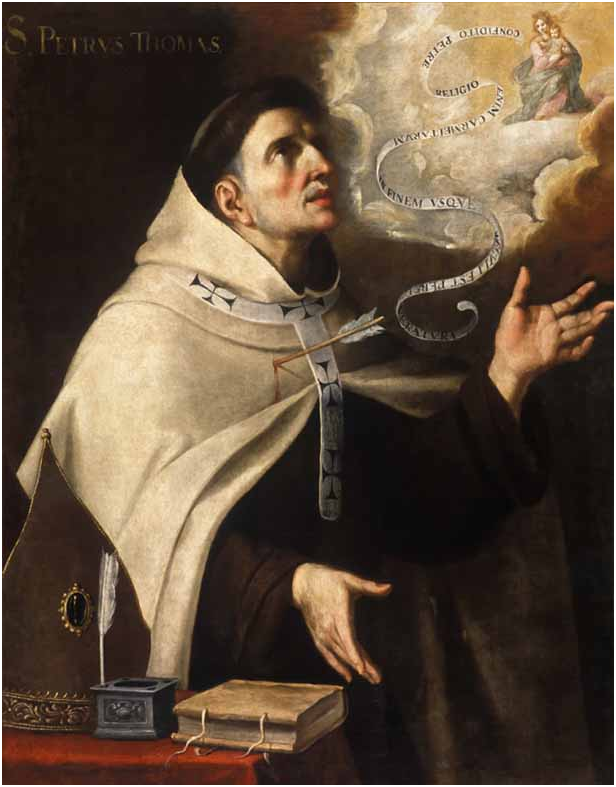Peter Thomas (1305–1366), also known as Petrus de Thomas or Pierre de Thomas, was a French Carmelite friar, preacher, and teacher. He was entrusted with a number of diplomatic missions by the Holy Sea. Thomas was canonised by Pope Urban VIII in 1628. He entered the Carmelite Order at the age of twenty-one and made his profession of religious vows at Bergerac, where he taught for two years.
In 1345 he was the Order's Procurator General and an official preacher at the Papal Court of Pope Clement VI at Avignon. In April 1357, Thomas went as papal legate to Constantinople to receive the submission of the Emperor of Byzantium to the Roman Catholic Church in exchange for military support of the West to block the expansion of the Ottoman Empire. But the military support promised in the exchanges did not materialise.
In 1359, Pope Innocent VI appointed Peter Thomas Universal Legate for the East. In the summer of 1359, Bishop Thomas left for Smyrna, where he strengthened the city's defences, paid the soldiers, ensured the supply of the city and the appointment of a new governor. He also went to Constantinople and took part in the battles of Lampsach. Philippe de Mezières wrote: Pierre Thomas was "tireless, leading the troops into battle by his example and his exhortations, sometimes in Smyrna, sometimes in Rhodes, sometimes in Constantinople, sometimes in Cyprus, sometimes in the island of Crete, and sometimes in Turkey with a few galleys".
In Christmas 1359, Thomas was in Rhodes and sick with a long illness, but had recovered sufficiently by Easter to perform the coronation of Peter I of Cyprus and Eleanor of Aragon as king and queen of Jerusalem in Famagusta on April 5, 1360. At the end of 1361, he was in Cyprus during a great plague epidemic and organised masses, prayers, and processions in Nicosia and then in Famagusta to stop the plague.
Then war broke out between Cyprus and Genoa, and Urban V sent him to negotiate terms there as well. In 1364, Thomas became the Latin Patriarch of Constantinople. On 9 October 1365, the galleys and ships of Peter I of Cyprus disembarked in the port of Alexandria. It was captured quickly, and the crusaders were in the city the next day. Once in the city, the Christians ransacked the city, looted it, partially burned it and massacred its population. On October 11, 1365, the city was taken. But this victory was short-lived because the crusader soldiers, motivated by the lure of gain, were seized with fear at the idea that the Saracens would come to the rescue of the besieged city, which they soon did. After consultation and against the advice of Peter I of Cyprus and Peter Thomas, who urged them to hold out, the Crusaders with their rich booty, re-embarked for Cyprus on 16 October 1365.
Around Christmas 1365, Thomas fell seriously ill. The cause of his death is not certain, because two versions are circulating. The first is that Pierre Thomas caught a cold during the celebrations of the Nativity by living too austerely and without taking into account the rigours of winter, which caused a fever that led to his death. The second hypothesis is that Thomas had been injured during the capture of Alexandria and that his death followed his wound. He died during the night of January 6-7, 1366, at Famagusta and was buried in the choir of the church of the Carmelites.
Considered a saint during his lifetime by the people of Cyprus, known for his preaching, his virtuous and ascetic life and the fact that miracles were attributed to him already during his lifetime, the ecclesiastical process was initiated in Famagusta by the bishop Simon of Laodicea, on April 14, 1366. Peter I of Cyprus requested Pope Urban V to initiate a canonisation procedure, and that the transfer of the body outside the island of Cyprus be prohibited for a period of ten years. This decision would be widely exceeded because the body of the saint would never be transferred outside the island.
© Costas and Rita Severis Foundation
The 'Did you Know' series is supported by The Hellenic Initiative Canada.







